When the previous conversation with Hristofor in the article “Meeting a Kayak” was finished, adriaticnature was sure that a full stop at the end of the talk was actually only a semi-colon, because there were still a lot of questions to the expert on vertical jigging from the kayak from Sofia, Bulgaria. Finally, Hristofor found some free time to continue the dialogue, and adriaticnature was glad to ask all the questions.

(Hristofor Pamyatnih. Photo © Hristofor Pamyatnih)
Hi, Hristofor! Thanks for taking the time again, and we are back to conversations about sea fishing from the kayak. The kayak provides us with opportunities to reach the places, to which no paths have been made yet, to fish in bays and estuarine parts of the sea, which seabasses, bluefishes, and leerfishes simply adore, to catch fish, including groupers, dentexes, bonitos, little tunnies, and other inhabitants, casting various lures under the rocks.
But I want to talk to you about vertical jigging, or rather about baiting, which implies the bait animation with the help of a vertical component. Let’s consider the diversity of baits, and let’s start with jigs, or metal jigs.
Perhaps, it would be right to divide them into 2 groups. One group is designed for a high-speed retrieve. Usually, these jigs are elongated, “fall” quickly through the water column and don’t have a strongly pronounced own way of playing. The other group comprises jigs designed for a slow retrieve. The “crumble” while falling. It’s the so-called “slow”. Tell us, please: which of them do you prefer when fishing from a kayak? And if you use both, in what situations and on what grounds do you do it?
Hi! Attempts to classify “hardware” for vertical jigging based on the “slow” and “fast” principle are rather dubious. When I was just starting to fish with vertical jigging from the kayak, it was almost impossible to find the jigs of the desired type and size in Bulgaria. I had to settle for the limited range that was in stores.
I had tackles for “slow”, but I started fishing with Xesta “Nitro” and “Afterburner” jigs, which were specified by the manufacturer as bait for “fast” jigging. But in the end, they turned out to be absolutely versatile.
Later, when I was surfing the Internet, I became interested in the Temple Reef spinning rods and found the video, in which a Japanese angler caught tuna using vertical jigging with Xesta “Slow Emotion Flap”. The retrieve was more than fast.
What do I prefer? It’s hard to say. The more transparent and warmer – the faster.
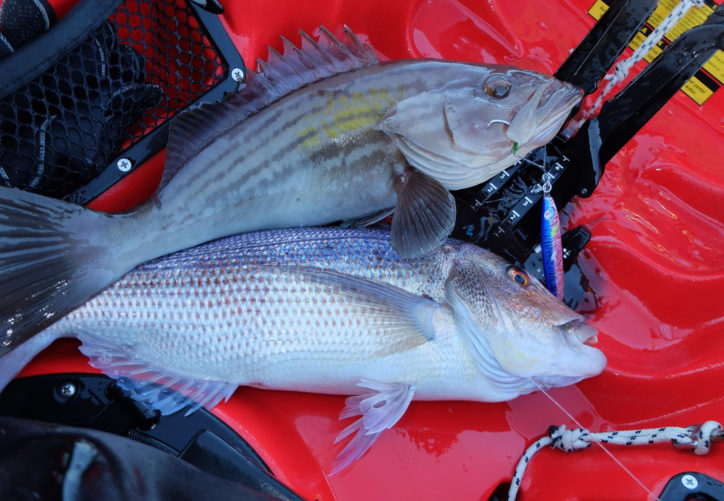
(Dentex and grouper caught from the kayak with a jig. Photo by © Hristofor Pamyatnih)
Of course, the purpose of fishing is important. Amberjacks mostly prefer a fast jig retrieve, groupers – a slow one. When the sea is calm for a long time, a few days or even a few weeks in a row, in my opinion, the predators prefer very slow bait retrieves. Especially if such weather is in spring.
I think that when the fish is in a “good” mood and feeds actively, the speed of the bait retrieve is not very important.
Lately, I’ve been using a “vertical ultralight” (a light spinning rod, braided line 0.8 PE thick, jigs weighing 30-80 grams) quite often. It produces very good results, in particular, in spring, when fish are often demanding. However, chances are high that the bait breaks off, especially if you don’t keep an eye on the braid and don’t tie up the fluorocarbon hooklink in time.
And now, when the choice of spinning rods for vertical jigging is rather wide, do you still use the set for the slow, or do you have two seats on the kayak, including one for “speed” jigging?
The main problem in the kayak is the lack of space. It’s simply inconvenient to take several fishing sets. Besides, in the case of my kayak, everything becomes wet and covered with salt after every fishing trip. The latter factor results in an extra “washing” of the tackle and shortens their lifespan. But what is even more important, is that fishing with classic tackle for “speed” jigging from the kayak is a rather difficult gymnastic exercise, much like acrobatic.
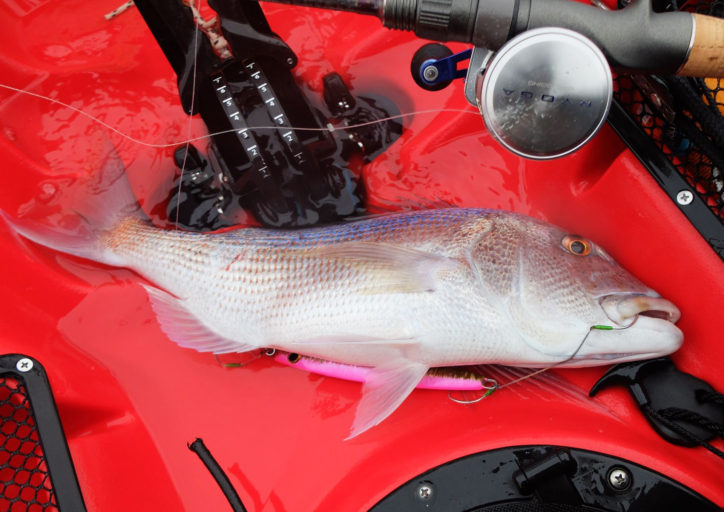
(Dentex caught from the kayak with a jig. Photo by © Hristofor Pamyatnih)
A few years ago, a Bulgarian seller gave me a Chinese spinning rod for testing. The rod was made by his company’s brand. The rod turned out to be very decent, though it was a little tougher than you need for the classic “slow” jigging. And I consider it to be the best for catching predators in Greece and Albania during those seasons and in the places, where I most often fish from the kayak. The only drawback was that it wasn’t good for “slow pitching”. Anyway, my nervous system doesn’t let me fish this way often – this method is too passive. Besides, I still haven’t found any clear advantages over other types of bait retrieves.
I’m going to purchase the “Temple Reef” spinning rod with similar features. But before doing it, I would like to retrofit my mountain bike, buy a new camera and do repairs in my apartment.
What are the fundamental differences between the usual “slow” and “slow pitch” jigging?
“Slow pitch” differs from “slow jig” in the fact that when you perform “pitching” you work almost only with a reel, and jigging implies using all your tackle. As a result, when you retrieve the bait with the help of “pitching”, the playing of the jig in the water turns out to be “delicate” and resembles a small neat fir-tree, and when jigging is used, it looks like broad spruce.

(Amberjack caught from the kayak with a jig. Photo by © Hristofor Pamyatnih)
In the case of “slow pitch”, the bait is thrown during the retrieve due to the “elasticity” of the taper. It’s meditative fishing. Fixed-spool reels can be good for a classic “slow” to some extent when fishing from the kayak. But in case of “slow pitch”, using exclusively multiplier reels is the only option. Believe me, it’s very unhandily to “turn” the fixed-spool reel by “sections” of 1/4 turn, 1/3 or 1/2, when you turn your body in the kayak towards fishing.
When you go to a new place to fish with the kayak, you probably take a “mandatory” minimum set of jigs. Give some tips to a beginner who starts practicing vertical jigging from the kayak. Shape? Weight? Colors? What else should you pay attention to when choosing jigs?
It all depends on the budget. For example, jigs produced by the Japanese company Seafloor Control are awesome. But I see no reason to leave 40 euros at the bottom after each “dead” hook. One Quick Zero jig by the Japanese company CB One is of my most favorite. I stopped buying them after losing another one. Considering the delivery to Bulgaria, they cost more than 40 euros.
Chinese jigs, mostly copies of Japanese brands, “work fine” with me. They have several drawbacks: the paint peels off quickly, and you shouldn’t buy models designed for “speed” jigging – they are made of lead alloy. They are bent very easily and quickly. They get out of shape. Moreover, they often “twist” the braided line to one side and it “kills” the braid very quickly.
(Catching two groupers with one jig. Video by © Hristofor Pamyatnih)
In hold in my hands some of the most efficient lures. These are Xesta jigs.
But the BumbleBee jig by Maxel produces probably the best results now. In general, I prefer to fish with asymmetric jigs. Haoli by the Japanese Company Lamble Bait is amazingly efficient jigs at a good price, although I haven’t been able to buy them for the last couple of years.
As for weight – 120-180 grams, if you use the braided line 1.5 PE. 40-80 grams – for “vertical ultralight”.
I prefer blue, pink and silver shades. I prefer the same colors if we’re talking about the stripes.
What is your attitude to the “offshore” soft plastic lures in the Mediterranean seas?
“Rubber” can be conditionally divided into 2 types. The former is Tail Rubber of inchiku and kabura type. The latter is “classic” soft plastic lures, for example, Black Minnow by the French company Fiiish. Offshore, “boat” Black minnow is more than a popular lure with fishermen, at least in Bulgaria. I don’t like a Black minnow. Firstly, I don’t like “hype” things. Secondly, such “toothed” fish as sea breams bite off their tails easily. And these lures are more expensive than jigs. Thirdly, the main ways of fishing with these lures imply dropping them down to the bottom and unreel the cord quickly. Or you can drag it along the bottom. All this stuff is rather boring.
I like inchiku and kabura, but I can’t say that I succeed with them. Porgies respect them, especially in summer. But I prefer to ride a bike through the mountains at this time of year. By the way, these lures helped me out in hopeless situations when others were silent. For example, in Montenegro, in the Bay of Kotor in spring.

(Swordfish caught with a jig from the kayak. Photo by © Hristofor Pamyatnih)
Do you have any favorite retrieve options for inchiku and kabura? Do many fishermen prefer their almost passive behavior in the water?
Probably not. The last time I caught a grouper was when I put down the paddle and stopped on the water to have a snack, and a kabura was just hanging under the board of the kayak. By the way, I caught porgies in the Bay of Kotor in a similar situation.
Many “specialized” spinning rods for various types of retrieve and types of lures have appeared on the market recently. There are slow, slow pitch, kabura, inchiku. In your opinion, should the angler pay attention to all these “specializations” of rods?
The main goal of manufacturers is to sell as many products as possible. But since “serious” producers, such as Shimano, Daiwa, Evergreen, and so on, produced them, then such a rod would probably be better suited to certain lures indeed.
However, you will most likely have difficulties with buying such rods in Europe. Extremely specialized spinning rods are rather exceptions in most cases. They are far from being the most popular. Dealers simply won’t order such spinning rods, if manufacturers stop forcing them to replenish their range with these models. And buying them in Japan, for example, is a dubious pleasure, the price including the delivery will equal a used and so beloved Volkswagen Golf in the Balkans-)
If the budget allows, and you really need a spinning rod that almost won’t be used at all – buy it without a doubt-).
Buying “rods” with such features in China, without even holding them in hands, is the same as buying a pig in a poke. Sometimes, Chinese manufacturers succeed. Sometimes, they don’t. And sometimes, they fail.

(Grouper caught with a jig from the kayak. Photo by © Hristofor Pamyatnih)
You constantly go fishing to new places with your kayak. Greece, Montenegro, Albania recently. How do you choose new locations for the next trip? Do you study navigation charts? Do you collect information from anglers?
Anglers rarely give correct information. Let’s start with the fact that there are fish everywhere. There are more fish in some places. That’s it. There are typical locations, and I know that a predator will hunt there, and, indeed, they are often clearly seen on the chart. For example, I studied the southeastern part of the Albanian Adriatic beforehand only using navigation charts, and later I found the fish exactly where I thought it was.
When you return to the places, where you caught fish successfully earlier, do you find the fish again on the “profitable” sites, or are marks in the navigator just an approximate guide for you?
My answer is that there is no point in obsessing about a certain site. There is a Bulgarian saying about a wolf that once found a dead lamb and then kept returning to the same place for 9 years, hoping to catch another one. I mean that I carefully check the relief of the bottom, where I had a bite previously. And the circumference of “exploration” can be twenty or two hundred meters.
Give advice to novice sea trophy hunters. What should they pay attention to, when choosing a fishing site first and foremost. Depths? Bottom relief? Flowing rivers? Under what conditions can fish from the kayak using vertical jigging produce better results?
You know the biggest fishing secret is where they caught the fish. All joking aside, the question is quite complicated. For the time being, I solve it for myself relying on intuition. But, of course, there are some signs of potentially successful places.
I never pay attention to the rivers and don’t think that it makes sense to fish “vertically” in the estuaries – usually, the river buries the whole bottom under the sand. On the other hand, I noticed that fish prefer the places, where at least some changes occur on the bottom: if there is sand under you, look for stones, if the bottom is rocky, look for sand. Porgies, for example, like a swampy bottom, a kind of black and brown clayey sand.
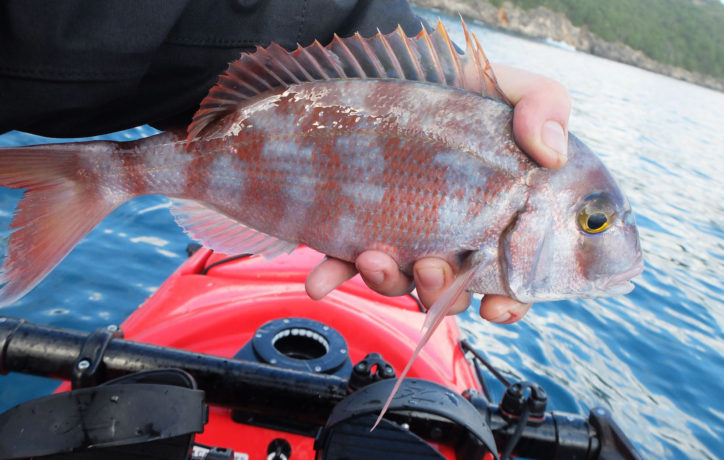
(Red porgy caught with an inchiku from the kayak. Photo by © Hristofor Pamyatnih)
As for the depths. It’s a whole other story. On the last fishing trip, I caught a considerable amount of fish at the depth of fewer than 30 meters. However, the usual “efficient” depth is 40-50 meters. It’s the depth, where the fish of a decent “culinary” size is caught. A culinary component is not in the last place for me-). Amberjacks weighing 10+ kilograms are very interesting to catch, but it’s not interesting to cook them at all.
The bottom relief, where I prefer to do “vertical jigging”, is relatively flat. I can’t remember the day when I successfully fished on an uneven bottom when the screen of the echo sounder showed sharp drops, large rocks and a bottom that looks like a “comb”. In my opinion, it is usually difficult to catch fish in such places. This doesn’t apply to the areas, where stones with a diameter of more than one and a half-two meters are scattered at the bottom. Fishing on such a bottom is often more than successful.
If you fish over a steep denting, where there is a sharp drop in depths, for example, from 40 to 60 meters, then, in most cases, the predator will hunt on the upper edge. There are usually no fish in the “ravines”, and if there are, then they are often random.
If a long and easy shoal, which is noticeably shallower than the surrounding bottom relief and more than 20 meters wide, enters the sea, this is a perfect place to look for fish. At such a location, it is fairly easy to control the speed of the kayak and the direction of the “drift”, and it is very convenient to fish such a shallow along the entire length.
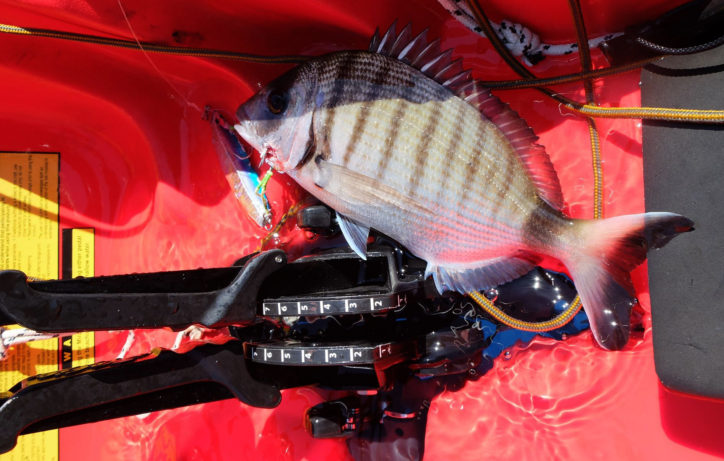
(White seabream caught with a jig from the kayak. Photo by © Hristofor Pamyatnih)
And a few words about the weather should be said. If the weather is perfect for kayaking, then the probability of catching fish is usually quite low. If it is cloudy, windy and there are waves – you should definitely go searching for predators. I recall only one fishing trip, when, with complete calm and a cloudless sky, we caught an enormous number of fish: about 2-3 dentexes, 4-5 groupers and about a dozen weighty amberjacks per fisherman.
In the previous article, we talked a little about echo sounders. Many fishermen seek to buy the most modern models, with more and more options. You use not the most sophisticated model. Do new technologies in the search for fish seem to you to be superfluous and unnecessary when it comes to sea fishing from a kayak?
Of course, they don’t-) I have a Humminbird 570 DI on my kayak, it’s not the simplest and the cheapest one. What I don’t like about modern models is that they mercilessly empty batteries. My sonar depletes the battery with a capacity of 7-ampere hours in 5 full days of fishing, lasting from dawn till dusk. New models of Simrad and Lowrance echo sounders deplete the same battery in 4 hours.
Of course, they are more sensitive and show fish a little better, but I don’t really want to carry 10 kilograms of batteries with me in the kayak.
The only thing my Humminbird really lacks is GPS. Of course, the sites can be saved on the phone, but if there is a strong drift, and you pull out the fish, and you take the phone – and you’re already a hundred meters aside.
I wonder why they still haven’t come up with an ultrasonic sensor that could be connected to a tablet or phone using the BTLE protocol and combining the sonar with a GPS navigator.
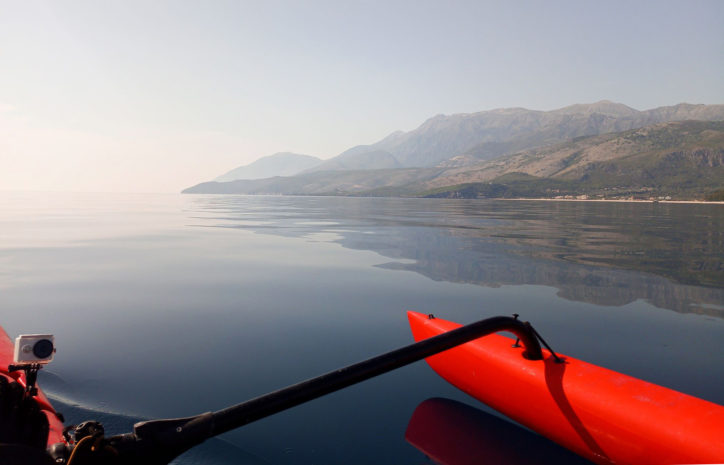
(Photo by © Hristofor Pamyatnih)
Tell me, what is the fundamental difference between fishing with vertical jigging from the kayak compared to the same fishing, but from the boat? What are the benefits of the kayak?
Low speed and maneuverability. I noticed that fish should be sought in our seas. The probability that the fish will come to you is much less than the probability that you will find the fish yourself.
Of course, the boat can travel much longer distances than the kayak, but the kayak is much easier to correctly position relative to the profitable site. And you can leisurely fish around the promising area as well. An additional electric motor with a GPS electric engine should be installed at the head of the boat and an additional person, who will steer it, is desirable onboard.
Besides, boarding more comfortable on the kayak, at least on my kayak. I can fish when the waves are rather high, which is quite difficult to do on the boat. My personal “record” is successful fishing from the kayak during a force six storm. Moreover, I was dragged through the waves for a couple of hours by a blue-finned tuna that bit the jig. I was really scared, I have no desire to repeat that day.